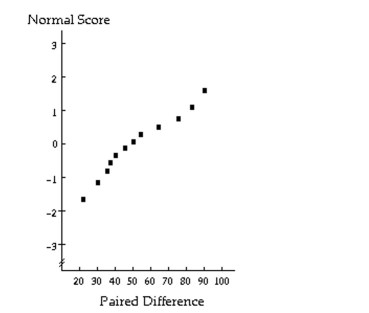A type of sampling (independent or paired) , sample size(s) , and a figure showing the results of preliminary data analyseson the sample(s) are provided. The intent is to employ the sample data to perform a hypothesis test to compare the meansof the two populations from which the data were obtained. Use the information provided to decide which procedureshould be applied.
-Paired; n = 12. A normal probability plot for the paired differences is given below. 
Definitions:
Negative Reinforcement
A type of operant conditioning that involves the removal of an unpleasant stimulus to increase the likelihood of a desired behavior.
Conditional Punishment
Rendering a consequence that reduces the likelihood of a behavior occurring in the future by associating it with an aversive outcome.
Primary Reinforcement
A naturally reinforcing stimulus, such as food or water, which fulfills a biological need.
Secondary Reinforcement
A process in behaviorism where a stimulus reinforces a behavior after it has been associated with a primary reinforcer, often taking the form of social approval, tokens, or money.
Q10: <span class="ql-formula" data-value="\begin{array} { r | r
Q11: A coach uses a new technique
Q12: An F-curve has df = (9, 10).
Q27: Referring to Scenario 20-1, what is the
Q43: In a group of 500 men and
Q65: In a clinical study of an allergy
Q68: A clinic gives a drug to a
Q81: The members of a board of
Q82: A magazine poll of unemployed men in
Q98: <img src="https://d2lvgg3v3hfg70.cloudfront.net/TB2675/.jpg" alt=" " class="answers-bank-image d-block" rel="preload"